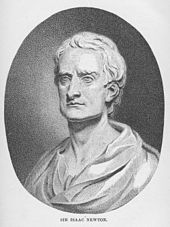Early life
Isaac Newton was born (according to the Julian calendar in use in England at the time) on Christmas Day, 25 December 1642, (NS 4 January 1643.[1]) at Woolsthorpe Manor in Woolsthorpe-by-Colsterworth, a hamlet in the county of Lincolnshire. He was born three months after the death of his father, a prosperous farmer also named Isaac Newton. Born prematurely, he was a small child; his mother Hannah Ayscough reportedly said that he could have fit inside a quart mug (≈ 1.1 litres). When Newton was three, his mother remarried and went to live with her new husband, the Reverend Barnabus Smith, leaving her son in the care of his maternal grandmother, Margery Ayscough. The young Isaac disliked his stepfather and maintained some enmity towards his mother for marrying him, as revealed by this entry in a list of sins committed up to the age of 19: "Threatening my father and mother Smith to burn them and the house over them."[8] Although it was claimed that he was once engaged,[9] Newton never married.
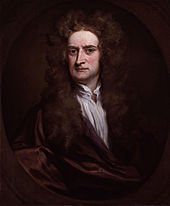
From the age of about twelve until he was seventeen, Newton was educated at The King's School, Grantham. He was removed from school, and by October 1659, he was to be found at Woolsthorpe-by-Colsterworth, where his mother, widowed by now for a second time, attempted to make a farmer of him. He hated farming.[10] Henry Stokes, master at the King's School, persuaded his mother to send him back to school so that he might complete his education. Motivated partly by a desire for revenge against a schoolyard bully, he became the top-ranked student.[11] The Cambridge psychologist Simon Baron-Cohen considers it "fairly certain" that Newton had Asperger syndrome.[12]
In June 1661, he was admitted to Trinity College, Cambridge as a sizar – a sort of work-study role.[13] At that time, the college's teachings were based on those of Aristotle, whom Newton supplemented with modern philosophers, such as Descartes, and astronomers such as Copernicus, Galileo, and Kepler. In 1665, he discovered the generalised binomial theorem and began to develop a mathematical theory that later became infinitesimal calculus. Soon after Newton had obtained his degree in August 1665, the university temporarily closed as a precaution against the Great Plague. Although he had been undistinguished as a Cambridge student,[14] Newton's private studies at his home in Woolsthorpe over the subsequent two years saw the development of his theories on calculus,[15] optics and the law of gravitation. In 1667, he returned to Cambridge as a fellow of Trinity.[16] Fellows were required to become ordained priests, something Newton desired to avoid due to his unorthodox views. Luckily for Newton, there was no specific deadline for ordination, and it could be postponed indefinitely. The problem became more severe later when Newton was elected for the prestigious Lucasian Chair. For such a significant appointment, ordaining normally could not be dodged. Nevertheless, Newton managed to avoid it by means of a special permission from Charles II (see "Middle years" section below).
Middle years
Mathematics
Newton's work has been said "to distinctly advance every branch of mathematics then studied".[17] His work on the subject usually referred to as fluxions or calculus, seen in a manuscript of October 1666, is now published among Newton's mathematical papers.[18] The author of the manuscript De analysi per aequationes numero terminorum infinitas, sent by Isaac Barrow to John Collins in June 1669, was identified by Barrow in a letter sent to Collins in August of that year as:[19]
Mr Newton, a fellow of our College, and very young ... but of an extraordinary genius and proficiency in these things.
Newton later became involved in a dispute with Leibniz over priority in the development of infinitesimal calculus (the Leibniz–Newton calculus controversy). Most modern historians believe that Newton and Leibniz developed infinitesimal calculus independently, although with very different notations. Occasionally it has been suggested that Newton published almost nothing about it until 1693, and did not give a full account until 1704, while Leibniz began publishing a full account of his methods in 1684. (Leibniz's notation and "differential Method", nowadays recognised as much more convenient notations, were adopted by continental European mathematicians, and after 1820 or so, also by British mathematicians.) Such a suggestion, however, fails to notice the content of calculus which critics of Newton's time and modern times have pointed out in Book 1 of Newton's Principia itself (published 1687) and in its forerunner manuscripts, such as De motu corporum in gyrum ("On the motion of bodies in orbit"), of 1684. The Principia is not written in the language of calculus either as we know it or as Newton's (later) 'dot' notation would write it. But his work extensively uses an infinitesimal calculus in geometric form, based on limiting values of the ratios of vanishing small quantities: in the Principia itself Newton gave demonstration of this under the name of 'the method of first and last ratios'[20] and explained why he put his expositions in this form,[21] remarking also that 'hereby the same thing is performed as by the method of indivisibles'.
Because of this, the Principia has been called "a book dense with the theory and application of the infinitesimal calculus" in modern times[22] and "lequel est presque tout de ce calcul" ('nearly all of it is of this calculus') in Newton's time.[23] His use of methods involving "one or more orders of the infinitesimally small" is present in his De motu corporum in gyrum of 1684[24] and in his papers on motion "during the two decades preceding 1684".[25]
Newton had been reluctant to publish his calculus because he feared controversy and criticism.[26] He was close to the Swiss mathematician Nicolas Fatio de Duillier. In 1691, Duillier started to write a new version of Newton's Principia, and corresponded with Leibniz.[27] In 1693 the relationship between Duillier and Newton deteriorated, and the book was never completed.
Starting in 1699, other members of the Royal Society (of which Newton was a member) accused Leibniz of plagiarism, and the dispute broke out in full force in 1711. The Royal Society proclaimed in a study that it was Newton who was the true discoverer and labelled Leibniz a fraud. This study was cast into doubt when it was later found that Newton himself wrote the study's concluding remarks on Leibniz. Thus began the bitter controversy which marred the lives of both Newton and Leibniz until the latter's death in 1716.[28]
Newton is generally credited with the generalised binomial theorem, valid for any exponent. He discovered Newton's identities, Newton's method, classified cubic plane curves (polynomials of degree three in two variables), made substantial contributions to the theory of finite differences, and was the first to use fractional indices and to employ coordinate geometry to derive solutions to Diophantine equations. He approximated partial sums of the harmonic series by logarithms (a precursor to Euler's summation formula), and was the first to use power series with confidence and to revert power series. Newton's work on infinite series was inspired by Simon Stevin's decimals.[29]
He was appointed Lucasian Professor of Mathematics in 1669 on Barrow's recommendation. In that day, any fellow of Cambridge or Oxford was required to become an ordained Anglican priest. However, the terms of the Lucasian professorship required that the holder not be active in the church (presumably so as to have more time for science). Newton argued that this should exempt him from the ordination requirement, and Charles II, whose permission was needed, accepted this argument. Thus a conflict between Newton's religious views and Anglican orthodoxy was averted.[30]
Optics
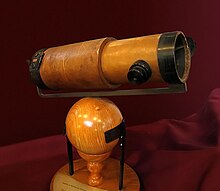
From 1670 to 1672, Newton lectured on optics.[32] During this period he investigated the refraction of light, demonstrating that a prism could decompose white light into a spectrum of colours, and that a lens and a second prism could recompose the multicoloured spectrum into white light.[33] Modern scholarship has revealed that Newton's analysis and resynthesis of white light owes a debt to corpuscular alchemy.[34]
He also showed that the coloured light does not change its properties by separating out a coloured beam and shining it on various objects. Newton noted that regardless of whether it was reflected or scattered or transmitted, it stayed the same colour. Thus, he observed that colour is the result of objects interacting with already-coloured light rather than objects generating the colour themselves. This is known as Newton's theory of colour.[35]

From this work, he concluded that the lens of any refracting telescope would suffer from the dispersion of light into colours (chromatic aberration). As a proof of the concept, he constructed a telescope using a mirror as the objective to bypass that problem.[36][37] Building the design, the first known functional reflecting telescope, today known as a Newtonian telescope,[37] involved solving the problem of a suitable mirror material and shaping technique. Newton ground his own mirrors out of a custom composition of highly reflective speculum metal, using Newton's rings to judge the quality of the optics for his telescopes. In late 1668[38] he was able to produce this first reflecting telescope. In 1671, the Royal Society asked for a demonstration of his reflecting telescope.[39] Their interest encouraged him to publish his notes On Colour, which he later expanded into his Opticks. When Robert Hooke criticised some of Newton's ideas, Newton was so offended that he withdrew from public debate. Newton and Hooke had brief exchanges in 1679–80, when Hooke, appointed to manage the Royal Society's correspondence, opened up a correspondence intended to elicit contributions from Newton to Royal Society transactions,[40] which had the effect of stimulating Newton to work out a proof that the elliptical form of planetary orbits would result from a centripetal force inversely proportional to the square of the radius vector (see Newton's law of universal gravitation – History and De motu corporum in gyrum). But the two men remained generally on poor terms until Hooke's death.[41]
Newton argued that light is composed of particles or corpuscles, which were refracted by accelerating into a denser medium. He verged on soundlike waves to explain the repeated pattern of reflection and transmission by thin films (Opticks Bk.II, Props. 12), but still retained his theory of 'fits' that disposed corpuscles to be reflected or transmitted (Props.13). Later physicists instead favoured a purely wavelike explanation of light to account for the interference patterns, and the general phenomenon of diffraction. Today's quantum mechanics, photons and the idea of wave–particle duality bear only a minor resemblance to Newton's understanding of light.
In his Hypothesis of Light of 1675, Newton posited the existence of the ether to transmit forces between particles. The contact with the theosophist Henry More, revived his interest in alchemy. He replaced the ether with occult forces based on Hermetic ideas of attraction and repulsion between particles. John Maynard Keynes, who acquired many of Newton's writings on alchemy, stated that "Newton was not the first of the age of reason: He was the last of the magicians."[42] Newton's interest in alchemy cannot be isolated from his contributions to science.[5] This was at a time when there was no clear distinction between alchemy and science. Had he not relied on the occult idea of action at a distance, across a vacuum, he might not have developed his theory of gravity. (See also Isaac Newton's occult studies.)
In 1704, Newton published Opticks, in which he expounded his corpuscular theory of light. He considered light to be made up of extremely subtle corpuscles, that ordinary matter was made of grosser corpuscles and speculated that through a kind of alchemical transmutation "Are not gross Bodies and Light convertible into one another, ...and may not Bodies receive much of their Activity from the Particles of Light which enter their Composition?"[43] Newton also constructed a primitive form of a frictional electrostatic generator, using a glass globe (Optics, 8th Query).
In an article entitled "Newton, prisms, and the 'opticks' of tunable lasers[44] it is indicated that Newton in his book Opticks was the first to show a diagram using a prism as a beam expander. In the same book he describes, via diagrams, the use of multiple-prism arrays. Some 278 years after Newton's discussion, multiple-prism beam expanders became central to the development of narrow-linewidth tunable lasers. Also, the use of these prismatic beam expanders led to the multiple-prism dispersion theory.[44]
Mechanics and gravitation

In 1679, Newton returned to his work on (celestial) mechanics, i.e., gravitation and its effect on the orbits of planets, with reference to Kepler's laws of planetary motion. This followed stimulation by a brief exchange of letters in 1679–80 with Hooke, who had been appointed to manage the Royal Society's correspondence, and who opened a correspondence intended to elicit contributions from Newton to Royal Society transactions.[40] Newton's reawakening interest in astronomical matters received further stimulus by the appearance of a comet in the winter of 1680–1681, on which he corresponded with John Flamsteed.[45] After the exchanges with Hooke, Newton worked out a proof that the elliptical form of planetary orbits would result from a centripetal force inversely proportional to the square of the radius vector (see Newton's law of universal gravitation – History and De motu corporum in gyrum). Newton communicated his results to Edmond Halley and to the Royal Society in De motu corporum in gyrum, a tract written on about 9 sheets which was copied into the Royal Society's Register Book in December 1684.[46] This tract contained the nucleus that Newton developed and expanded to form the Principia.
The Principia was published on 5 July 1687 with encouragement and financial help from Edmond Halley. In this work, Newton stated the three universal laws of motion that enabled many of the advances of the Industrial Revolution which soon followed and were not to be improved upon for more than 200 years, and are still the underpinnings of the non-relativistic technologies of the modern world. He used the Latin word gravitas (weight) for the effect that would become known as gravity, and defined the law of universal gravitation.
In the same work, Newton presented a calculus-like method of geometrical analysis by 'first and last ratios', gave the first analytical determination (based on Boyle's law) of the speed of sound in air, inferred the oblateness of the spheroidal figure of the Earth, accounted for the precession of the equinoxes as a result of the Moon's gravitational attraction on the Earth's oblateness, initiated the gravitational study of the irregularities in the motion of the moon, provided a theory for the determination of the orbits of comets, and much more.
Newton made clear his heliocentric view of the solar system – developed in a somewhat modern way, because already in the mid-1680s he recognised the "deviation of the Sun" from the centre of gravity of the solar system.[47] For Newton, it was not precisely the centre of the Sun or any other body that could be considered at rest, but rather "the common centre of gravity of the Earth, the Sun and all the Planets is to be esteem'd the Centre of the World", and this centre of gravity "either is at rest or moves uniformly forward in a right line" (Newton adopted the "at rest" alternative in view of common consent that the centre, wherever it was, was at rest).[48]
Newton's postulate of an invisible force able to act over vast distances led to him being criticised for introducing "occult agencies" into science.[49] Later, in the second edition of the Principia (1713), Newton firmly rejected such criticisms in a concluding General Scholium, writing that it was enough that the phenomena implied a gravitational attraction, as they did; but they did not so far indicate its cause, and it was both unnecessary and improper to frame hypotheses of things that were not implied by the phenomena. (Here Newton used what became his famous expression "hypotheses non fingo"[50]).
With the Principia, Newton became internationally recognised.[51] He acquired a circle of admirers, including the Swiss-born mathematician Nicolas Fatio de Duillier, with whom he formed an intense relationship. This abruptly ended in 1693, and at the same time Newton suffered a nervous breakdown.[52]
Classification of cubics
Besides the work of Newton and others on calculus, the first important demonstration of the power of analytic geometry was Newton's classification of cubic curves in the Euclidean plane in the late 1600s. He divided them into four types, satisfying different equations, and in 1717 Stirling, probably with Newton's help, proved that every cubic was one of these four. Newton also claimed that the four types could be obtained by plane projection from one of them, and this was proved in 1731.[53]
Later life
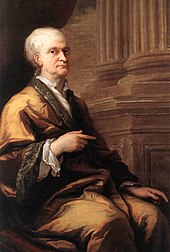
In the 1690s, Newton wrote a number of religious tracts dealing with the literal interpretation of the Bible. Henry More's belief in the Universe and rejection of Cartesian dualism may have influenced Newton's religious ideas. A manuscript he sent to John Locke in which he disputed the existence of the Trinity remained unpublished until 1785, more than half a century after his death.[54][55] Later works – The Chronology of Ancient Kingdoms Amended (1728) and Observations Upon the Prophecies of Daniel and the Apocalypse of St. John (1733) – were published after his death. He also devoted a great deal of time to alchemy (see above).
Newton was also a member of the Parliament of England for Cambridge University in 1689–90 and 1701–2, but according to some accounts his only comments were to complain about a cold draught in the chamber and request that the window be closed.[56][57][58]
Newton moved to London to take up the post of warden of the Royal Mint in 1696, a position that he had obtained through the patronage of Charles Montagu, 1st Earl of Halifax, then Chancellor of the Exchequer. He took charge of England's great recoining, somewhat treading on the toes of Lord Lucas, Governor of the Tower (and securing the job of deputy comptroller of the temporary Chester branch for Edmond Halley). Newton became perhaps the best-known Master of the Mint upon the death of Thomas Neale in 1699, a position Newton held for the last 30 years of his life.[59][60] These appointments were intended as sinecures, but Newton took them seriously, retiring from his Cambridge duties in 1701, and exercising his power to reform the currency and punish clippers and counterfeiters. As Master of the Mint in 1717 in the "Law of Queen Anne" Newton moved the Pound Sterling de facto from the silver standard to the gold standard by setting the bimetallic relationship between gold coins and the silver penny in favour of gold. This caused silver sterling coin to be melted and shipped out of Britain. Newton was made President of the Royal Society in 1703 and an associate of the French Académie des Sciences. In his position at the Royal Society, Newton made an enemy of John Flamsteed, the Astronomer Royal, by prematurely publishing Flamsteed's Historia Coelestis Britannica, which Newton had used in his studies.[61]

In April 1705, Queen Anne knighted Newton during a royal visit to Trinity College, Cambridge. The knighthood is likely to have been motivated by political considerations connected with the Parliamentary election in May 1705, rather than any recognition of Newton's scientific work or services as Master of the Mint.[63] Newton was the second scientist to be knighted, after Sir Francis Bacon.
Towards the end of his life, Newton took up residence at Cranbury Park, near Winchester with his niece and her husband, until his death in 1727.[64] His half-niece, Catherine Barton Conduitt,[65] served as his hostess in social affairs at his house on Jermyn Street in London; he was her "very loving Uncle,"[66] according to his letter to her when she was recovering from smallpox.
Newton died in his sleep in London on 20 March 1727 (OS 20 March 1726; NS 31 March 1727)[1] and was buried in Westminster Abbey. Voltaire was present at his funeral and praised the British for honoring a scientist of heretical religious beliefs with burial there. A bachelor, he had divested much of his estate to relatives during his last years, and died intestate. After his death, Newton's hair was examined and found to contain mercury, probably resulting from his alchemical pursuits. Mercury poisoning could explain Newton's eccentricity in late life.[67]
After death
Fame
The mathematician Joseph-Louis Lagrange often said that Newton was the greatest genius who ever lived, and once added that Newton was also "the most fortunate, for we cannot find more than once a system of the world to establish."[68] English poet Alexander Pope was moved by Newton's accomplishments to write the famous epitaph:
Nature and nature's laws lay hid in night;
God said "Let Newton be" and all was light.
Newton himself had been rather more modest of his own achievements, famously writing in a letter to Robert Hooke in February 1676:
If I have seen further it is by standing on the shoulders of giants.[69]
Two writers think that the above quote, written at a time when Newton and Hooke were in dispute over optical discoveries, was an oblique attack on Hooke (said to have been short and hunchbacked), rather than – or in addition to – a statement of modesty.[70][71] On the other hand, the widely known proverb about standing on the shoulders of giants published among others by 17th-century poet George Herbert (a former orator of the University of Cambridge and fellow of Trinity College) in his Jacula Prudentum (1651), had as its main point that "a dwarf on a giant's shoulders sees farther of the two", and so its effect as an analogy would place Newton himself rather than Hooke as the 'dwarf'.
In a later memoir, Newton wrote:
I do not know what I may appear to the world, but to myself I seem to have been only like a boy playing on the sea-shore, and diverting myself in now and then finding a smoother pebble or a prettier shell than ordinary, whilst the great ocean of truth lay all undiscovered before me.[72]
In 1816 a tooth said to have belonged to Isaac Newton was sold for £730[73] (us$3,633) in London to an aristocrat who passed to have it set in a ring.[74] The Guinness World Records 2002 classified it as the most valuable tooth, which would value approximately £25,000 (us$35,700) in late 2001's terms.[74] Who has bought it and to whom it currently pertains are mysteries.
Albert Einstein kept a picture of Newton on his study wall alongside ones of Michael Faraday and James Clerk Maxwell.[75] Newton remains influential to today's scientists, as demonstrated by a 2005 survey of members of Britain's Royal Society (formerly headed by Newton) asking who had the greater effect on the history of science, Newton or Einstein. Royal Society scientists deemed Newton to have made the greater overall contribution.[76] In 1999, an opinion poll of 100 of today's leading physicists voted Einstein the "greatest physicist ever;" with Newton the runner-up, while a parallel survey of rank-and-file physicists by the site PhysicsWeb gave the top spot to Newton.[77]
Commemorations
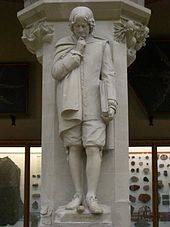
Newton's monument (1731) can be seen in Westminster Abbey, at the north of the entrance to the choir against the choir screen, near his tomb. It was executed by the sculptor Michael Rysbrack (1694–1770) in white and grey marble with design by the architect William Kent. The monument features a figure of Newton reclining on top of a sarcophagus, his right elbow resting on several of his great books and his left hand pointing to a scroll with a mathematical design. Above him is a pyramid and a celestial globe showing the signs of the Zodiac and the path of the comet of 1680. A relief panel depicts putti using instruments such as a telescope and prism.[78] The Latin inscription on the base translates as:
Here is buried Isaac Newton, Knight, who by a strength of mind almost divine, and mathematical principles peculiarly his own, explored the course and figures of the planets, the paths of comets, the tides of the sea, the dissimilarities in rays of light, and, what no other scholar has previously imagined, the properties of the colours thus produced. Diligent, sagacious and faithful, in his expositions of nature, antiquity and the holy Scriptures, he vindicated by his philosophy the majesty of God mighty and good, and expressed the simplicity of the Gospel in his manners. Mortals rejoice that there has existed s
نظرات شما عزیزان:
برچسبها: ali nemati, kavoshgaran, newton, pish be soie elm,


 آمار
وب سایت:
آمار
وب سایت:
 تاريخ ارسال : دو شنبه 20 خرداد 1392
تاريخ ارسال : دو شنبه 20 خرداد 1392
 دسته بندي : <-CategoryName->
دسته بندي : <-CategoryName-> نويسنده : سبحان بدیعی
نويسنده : سبحان بدیعی